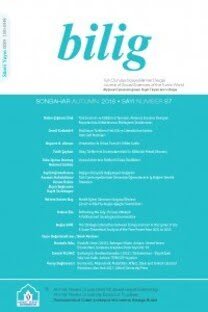Kırcaali Örneğinden Hareketle Bulgaristan’da Türkçenin Etnikdilsel Canlılığı
Bulgaristan Türkleri, anadilin sürdürümü, etnik-dilsel canlılık, Kırcaali’de Türk kimliği, Türkçe
The Ethnolinguistic Vitality of Turkish in Bulgaria Based on the Kardzhali Sample
Bulgarian Turks, language maintenance, ethnolinguistic vitality, Turkish identity in Kardzhali Bulgaria, Turkish,
___
- Bosnalı, Sonel (2007). İran Azerbaycan Türkçesi: Toplumdilbilimsel Bir İnceleme. İstanbul: Kebikeç Yay.
- Bourhis, R.Y., H. Giles ve D. Rosenthal (1981). “Notes on construction of a “subjective vitality questionnaire” for ethnolinguistic groups”. Journal of Multilingual and Multicultural Development 2 (2): 145-155.
- Bourhis, Richard Y. ve Rodrigue Landry (2008). “Group Vitality, Cultural Autonomy And The Wellness Of Language Minorities”. The Vitality of the English-Speaking Communities of Quebec: From Community Decline to Revial. Ed. Richard Y. Bourhis. Montreal, Qebec: CEETUM, Univercity Montreal. 185-212.
- Clyne, Michael (1991). Community languages: The Australian experience. Cambridge, UK: Cambridge University Press.
- Dayıoğlu, Ali (2005). Toplama Kampından Meclis’e – Bulgaristan’da Türk ve Müslüman Azınlığı. İstanbul: İletişim Yay.
- Edwards, John (1992). “Sociopolitical aspects of language maintenance and loss”. Maintenance and loss of minority languages. Ed. W. Fase, K. Jaspaert, & S. Kroon. Amsterdam, the Netherlands /Philadelphia, PA: John Benjamins. 37-54.
- Extra, Guus ve Kutlay Yağmur (Eds.) (2012). Language Rich Europe: Trends in policies and practices for multilingualism in Europe. Cambridge: British Council/Cambridge University Press.
- Giles, H., R.Y. Bourhis ve D. M. Taylor (1977). “Toward a theory of language in ethnic group relations”. Language, Ethnicity and Intergroup Relations. Ed. H. Giles. London: Academic Press.
- Grosjean, François (1982). Life with two languages: An introduction to bilingualism. Cambridge, Mass: Harvard University Press.
- Haksöz, Cengiz (2007). Linguistic Rights Of The Turkish Minority In Bulgaria. Yüksek Lisans Tezi. Ankara: Orta Doğu Teknik Üniversitesi.
- Kaleşi, Hasan (1979). XV. Asırdan XVII. Asrın Nihayetine Kadar Yugoslav Topraklarında Şark Medeniyeti. Çev. Ali Aksu. Türk Dünyası Araştırmaları. C.1. S.1.
- Kipp, S., M. Clyne ve A. Pauwels (1995). Immigration and Australia’s language resources. Canberra, Australia: AGPS.
- Memişoğlu, Hüseyin (2002). Geçmişten Günümüze Bulgaristan’da Türk Eğitim Tarihi. Ankara: Kültür ve Turizm Bakanlığı Yay.
- Meyerhoff, Miriam (2006). Introduction to sociolinguistics. NY: Routledge.
- Myers-Scotton, Carol (2006). Multiple Voices: An Introduction to Bilingualism. Blackwell.
- Mutlu, Emel ve Suzan Kavanoz (2010). “Mother Tongue Education of Turkish Minority in Bulgaria”. Uluslararası Sosyal Araştırmalar Dergisi 3 (14): 363-384.
- Özlem, Kader (2008). “Bulgaristan Türklerinin Tarihsel İçinde Dönüşümü, AB Üyelik Süreci ve Türk Azınlığa Etkileri”. Uluslararası Sosyal Araştırmalar Dergisi ½ (Winter): 341-371.
- Sachdev, Itesh ve Richard Y. Bourhis (2001). “Multilingual communication”. The New Handbook of Language and Social Psychology. Ed. W. P. Robinson and H. Giles. Chichester: Wiley. 407–28.
- _____. (2005). “Multilingual Communication and Social Identification”. Intergroup Communication. Multiple Perspectives. Ed. Harwood, J. And Giles, H. New York: Peter Lang. 65-91.
- Smolicz, J. J. (1981). “Core values and cultural identity”. Ethnic and Racial Studies 4: 75-90.
- Şimşir, Bilal (2009). Bulgaristan Türkleri. İstanbul: Bilgi Yay.
- Taş, Muharrem (2007). Bulgaristan ve Yunanistan’da Türk Azınlıkların Siyasi Hakları. Yüksek Lisans Tezi. Sakarya: Sakarya Üniversitesi.
- Toğrol, Beğlan (1989). 112 Yıllık Göç (1878–1989). İstanbul: Boğaziçi Üniversitesi Matbaası.
- Yağmur, Kutlay (1997). “Sociolinguistic Aspects of First Language Attrition Among Turkish Migrants in Sydney”. VIII. Uluslararası Türk Dilbilimi Konferansı Bildirileri. Haz. Kamile İmer-N. Engin Uzun. Ankara Üniversitesi Basımevi. 231-241.
- _____, (2009). “Language use and ethnolinguistic vitality of Turkish compared with the Dutch in the Netherlands”. Journal of Multilingual and Multicultural Development 30 (3): 219-233.
- _____, (2011). “Does ethnolinguistic vitality theory account for the actual vitality of ethnic groups? A critical evaluation”. Journal of Multilingual and Multicultural Development 32 (2): 110-121.
- Yağmur, Kutlay, Kees de Bot ve Korzilius Hubert (1999). “Language Attrition, Language Shift and Ethnolingustic Vitality of Turkish in Australia”. Journal of Multilingual and Multicultural Development 20 (1): 51-69.
- Yağmur, Kutlay ve Mehmet Ali Akıncı (2003). “Language use, choice, maintenance, and ethnolinguistic vitality of Turkish speakers in France: intergenerational differences”. International Journal of The Sociology of Language 164: 107-128.
- Yağmur, Kutlay ve Martin Ehala (2011). “Tradition and innovation in the ethnolinguistic vitality theory”. Journal of Multilingual and Multicultural Development 32 (2): 101-109.
- Yağmur, Kutlay ve Fons J. R. van de Vijver (2012). “Acculturation and language orientations of Turkish immigrants in Australia, France, Germany, and the Netherlands”. Journal of Cross-Cultural Psychology 43 (7): 1110-1130.
- Yenisoy, Hayriye (2012). Bulgaristan’da Türkçe Basın (1865-2010). http://www.kircaalihaber.com/?pid=8&id_aktualno=296%20class= [Erişim tarihi: 08.06.2012}.
- ISSN: 1301-0549
- Yayın Aralığı: Yılda 4 Sayı
- Başlangıç: 1996
- Yayıncı: Ahmet Yesevi Üniversitesi
Kosovalı Türkler: Dilleri ve Kültürleri
Avustralya’daki Türkçe Konuşurlarının Kültürel Yönelimlerinde Nesiller Arası Farklılıklar
Fransa’daki Türk Göçmenlerinin Etnik ve Dinî Kimlik Algıları
Federal Almanya’da Yayımlanan Türkçe Günlük Gazetelerin Dil Kullanımı Üzerine
ABD’de Türkçe Öğretimi: Zorluklar, Fırsatlar, Aidiyet ve Kimlik
Sınıftaki Rakip Söylemler: Berlin’de Türkçe Öğretimi
Belçika Okullarında Türkçe Konuşmak: Öğretmen Düşünceleri ve Asıl Sonuçları
Orhan AĞIRDAĞ, Kathelijne JORDENS, Mieke Van HOUTTE
Batı Trakya Türklerinin Anadillerine ve Kültürlerine Karşı Tutumları
